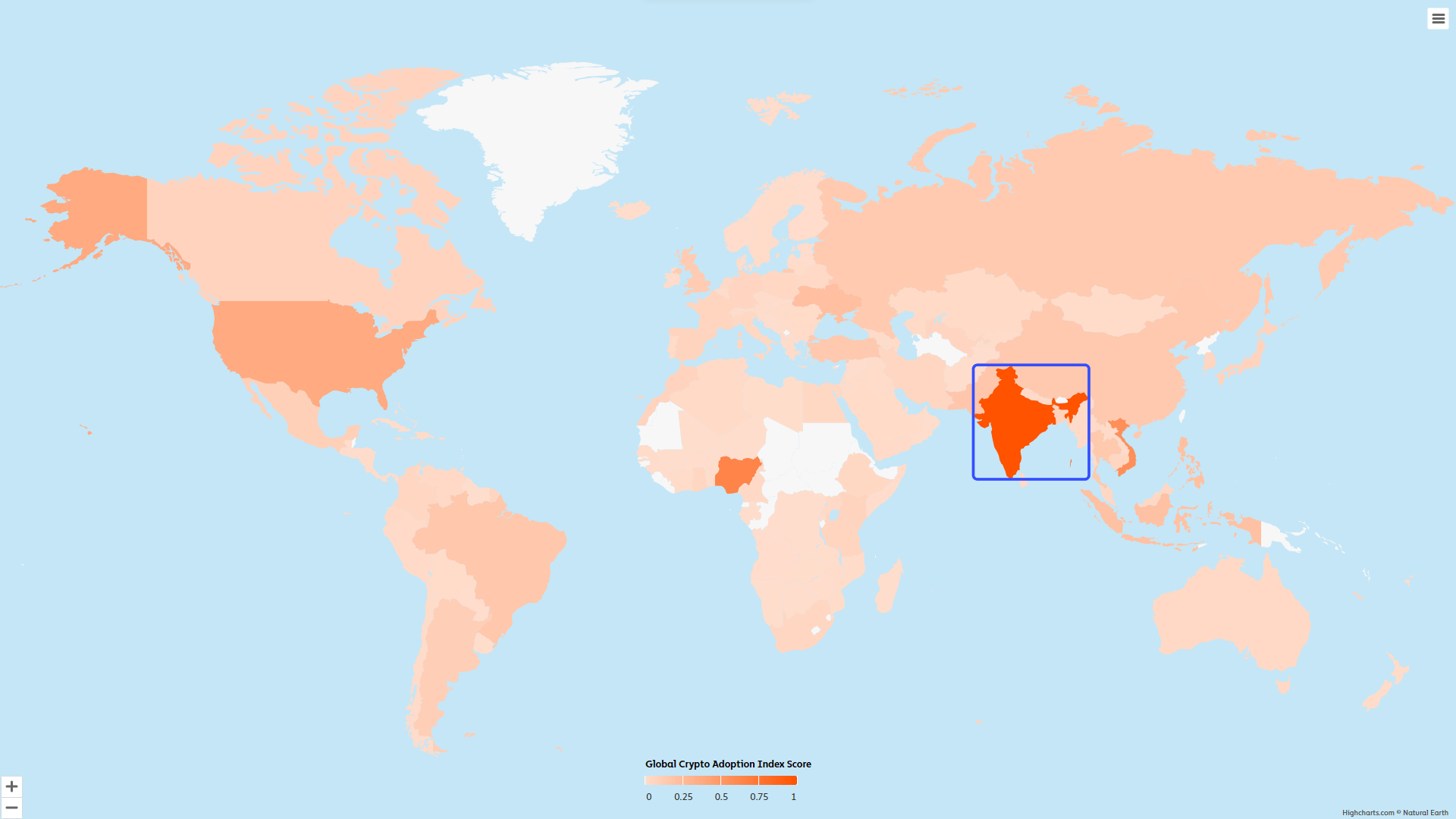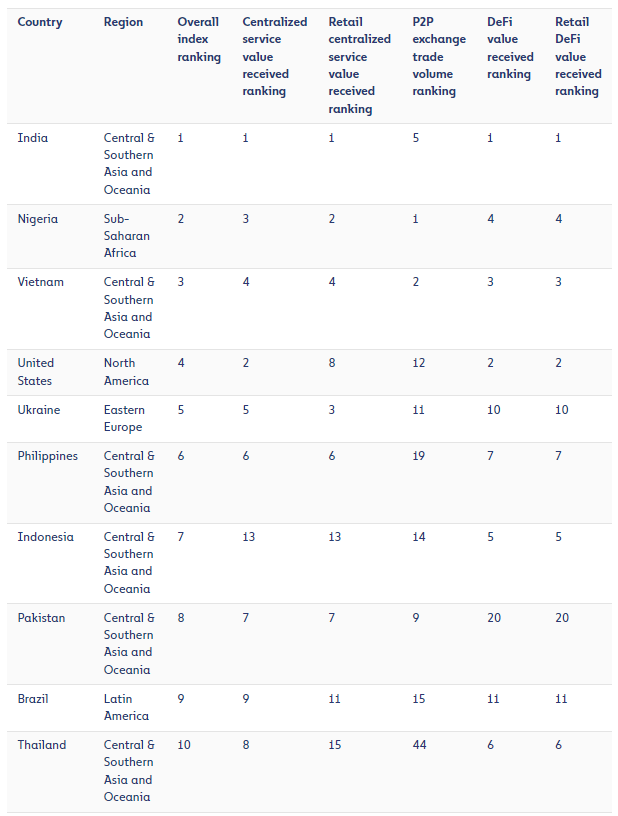In the Chainalysis 2023 Global Grassroots Crypto Adoption Index, the leading positions were clinched by India and Vietnam
Chainalysis, the blockchain data analytics company, has recently published its updated Global Crypto Adoption Index. Leading the index are India, Nigeria, and Vietnam, with the United States, Ukraine, the Philippines, and Indonesia following closely. Notably, Chainalysis observed that the Central & Southern Asia and Oceania (CSAO) region prominently dominates the top rankings, with six out of the top ten countries situated within this region.
Global Grassroots Crypto Adoption Index
Blockchain analytics company Chainalysis recently shared a preview of its upcoming 2023 Geography of Cryptocurrency report. This preview includes the release of Chainalysis’ fourth annual Global Crypto Adoption Index. The full report is slated for publication next month.
Chainalysis elaborated on their methodology, stating that they blend on-chain data with real-world data to assess which countries are at the forefront of grassroots crypto adoption. They noted that they evaluated data from 154 countries with sufficient information available. Furthermore, they explained that the Global Crypto Adoption Index aims to identify countries where the most significant proportion of people are investing a substantial portion of their wealth in cryptocurrencies.
The index comprises five sub-indexes, each based on a country’s usage of various types of cryptocurrency services. In the latest index rankings, India secures the top position, followed by Nigeria, Vietnam, the United States, Ukraine, the Philippines, and Indonesia.

The index is constructed from five sub-indexes, each shedding light on different facets of crypto adoption.
- Centralized Exchange Activity: This sub-index evaluates the cryptocurrency trading activity on centralized exchanges and focuses on countries where this activity significantly exceeds their average wealth (PPP per capita).
- Retail Value on Centralized Exchanges: It measures the cryptocurrency activities of individual users on centralized platforms, with an emphasis on countries where retail transactions are relatively smaller compared to their average wealth.
- P2P Exchange Volume: This sub-index prioritizes emerging markets and concentrates on countries where a substantial portion of residents’ wealth is directed towards peer-to-peer (P2P) cryptocurrency trades.
- Value from DeFi Protocols: This sub-index ranks countries based on their transaction volume in decentralized finance (DeFi) protocols, spotlighting those with active residents in the DeFi sector relative to their wealth.
- Retail Value from DeFi Protocols: This sub-index focuses on non-professional users in the DeFi space, identifying countries where smaller transactions by individual users are notably higher compared to their average wealth.
According to the index, India ranks first overall, followed by Nigeria, Vietnam, the U.S., Ukraine, the Philippines, and Indonesia.

The first key takeaway here is that the Central & Southern Asia and Oceania (CSAO) region dominates the top of the index, with six of the top ten countries located in the region. As we explore in the full report, the circumstances driving adoption in each CSAO country are unique, which leads to different usage trends and breakdowns of the most popular services.
We’re excited to release our fourth annual Global Crypto Adoption Index! Check out our blog to see 2023’s top countries for grassroots crypto adoption along with some key takeaways. https://t.co/czQb7cXhqP
— Chainalysis (@chainalysis) September 12, 2023
Asian, and LMI countries dominate the index

The 2023 index revealed a notable trend where Asian countries, particularly those in the Central and Southern Asia and Oceania (CSAO) region, dominated the rankings, with six of the top 10 countries hailing from this part of the world. In contrast, the United States secured the fourth position, and Ukraine held the fifth spot.
Interestingly, the index highlighted that lower middle-income (LMI) countries were taking the lead in grassroots crypto adoption. This indicated that nations with moderate economic development were making significant strides in embracing cryptocurrencies.
Despite the challenging bear market conditions, high-income countries were not left behind, as institutional adoption of cryptocurrencies appeared to be gaining momentum.
India makes strides in crypto adoption
India, in particular, has been making noteworthy progress in the adoption of cryptocurrencies. Recently, India hosted the G20 summit, which concluded just last week. During the summit, both the International Monetary Fund (IMF) and the Financial Stability Board (FSB) recommended the establishment of a comprehensive and standardized framework for dealing with cryptocurrencies. They explicitly rejected the idea of a blanket ban as the solution to managing crypto-related risks.
India has consistently emphasized the importance of achieving a global consensus on crafting cryptocurrency policies. Finance Minister Nirmala Sitharaman underscored this point during an event in April.
“No one country individually, in a matter of technology-driven, crypto assets, can effectively control it, because technology doesn’t have any borders, it can just pass through. So the very character of it being technology driven requires all countries to be on board, or else it will not be effective.”
Conclusion
In summarizing the findings of the Chainalysis Global Crypto Adoption Index for 2023, the data underscores a significant and undeniable shift toward digital financial systems worldwide. The most prominent observation is the rise of lower-middle-income (LMI) countries, which now account for a substantial share of global cryptocurrency adoption, notably led by India in multiple categories.
From a numerical standpoint, it is remarkable to note that LMI nations, encompassing 40% of the global population, have consistently demonstrated higher adoption rates compared to what was observed in the third quarter of 2020. This suggests that while high-income countries are steadily incorporating cryptocurrencies into their financial systems, developing nations are playing a pivotal role in driving the digital currency revolution forward.
As the world enters 2024, all eyes will be on the ever-evolving cryptocurrency landscape. With the momentum gained over the past year, LMI countries are poised to assume an even more significant role, potentially influencing the future course of global cryptocurrency adoption. The stage is set for continued growth and innovation in the crypto space, with diverse regions and nations contributing to the evolving narrative of digital finance.
Reference: Chainalysis
Learn more: FMC Crypto Insight Article
Crypto Insight, knowledge is your guiding light through the crypto universe

